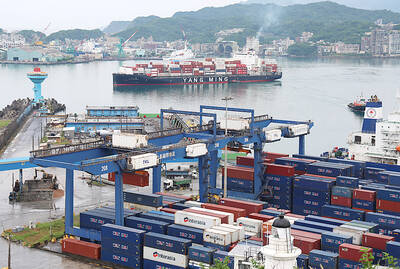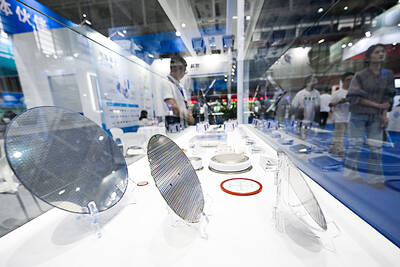China’s foreign-exchange reserves fell by a record last month as the central bank sold dollars to support the yuan after the biggest devaluation in two decades spurred bets on continued weakness.
The currency hoard declined by US$93.9 billion to US$3.56 trillion at the end of last month, from US$3.65 trillion a month earlier.
Economists surveyed by Bloomberg had forecast a median US$3.58 trillion.
The data illustrates the cost to China as it props up its currency and seeks to stem an outflow of capital that threatens to deepen the nation’s economic slowdown.
Chinese officials telegraphed confidence in the economy’s underlying solidity, predicting a stabilization in stocks and the currency at a gathering of G20 finance chiefs Friday and Saturday.
“If the central bank continues its intervention, China’s foreign-exchange reserves will continue to shrink — the heavier the intervention, the deeper the fall,” said Li Miaoxian (李苗獻), a Beijing-based analyst at Bocom International Holdings (交銀國際控股).
While the People’s Bank of China (PBOC) is trying to talk up the yuan exchange rate, it is “inevitable” that China will see continuous capital outflows and yuan depreciation pressure in the coming months, Li said.
The offshore yuan traded in Hong Kong erased gains after the reserves figures were announced. It was trading down 0.2 percent at 6.4795 to the US dollar as of 4:53pm yesterday.
The G20, meeting in Ankara, pledged to avoid tit-for-tat currency devaluations; the US Treasury secretary separately said that China should avoid persistent exchange-rate misalignments.
The biggest drop in China’s currency in 21 years last month had spurred concern that a weaker yuan will hurt countries exporting to China.
China’s reserves more than tripled in the past decade as the PBOC bought dollars to slow the yuan’s appreciation amid a swelling trade surplus. The PBOC holds almost a third of the world’s reserves.
To ensure the influx of money did not spur a surge in inflation, the PBOC raised the required reserve ratio for banks.
With reserves now in reverse, it has lowered reserve requirements, with economists forecasting further reductions.
Expectations that the US is to increase interest rates for the first time since 2006 this year are also luring funds from China, which has been loosening monetary policy since November last year.
“The hope for the PBOC, we believe, is that extreme selling pressure on the yuan subsides and they can allow a moderate depreciation to restore export competitiveness,” Bloomberg Intelligence economists Tom Orlik and Fielding Chen wrote in a note.
“The fear is that today’s data will reinforce the market view that the only way for the yuan to go is down, and further accelerate capital outflows,” they wrote.
A sustained shift from buying to selling from China would add pressure for Treasury yields to rise, the analysts wrote.
“The decline is significant, and it’s slightly deeper than we thought,” Hong Kong-based Credit Agricole CIB strategist Dariusz Kowalczyk said. “The level of the reserves remains very high and larger than what China needs, so there’s no threat to currency stability.”

The demise of the coal industry left the US’ Appalachian region in tatters, with lost jobs, spoiled water and countless kilometers of abandoned underground mines. Now entrepreneurs are eyeing the rural region with ambitious visions to rebuild its economy by converting old mines into solar power systems and data centers that could help fuel the increasing power demands of the artificial intelligence (AI) boom. One such project is underway by a non-profit team calling itself Energy DELTA (Discovery, Education, Learning and Technology Accelerator) Lab, which is looking to develop energy sources on about 26,305 hectares of old coal land in

Taiwan’s exports soared 56 percent year-on-year to an all-time high of US$64.05 billion last month, propelled by surging global demand for artificial intelligence (AI), high-performance computing and cloud service infrastructure, the Ministry of Finance said yesterday. Department of Statistics Director-General Beatrice Tsai (蔡美娜) called the figure an unexpected upside surprise, citing a wave of technology orders from overseas customers alongside the usual year-end shopping season for technology products. Growth is likely to remain strong this month, she said, projecting a 40 percent to 45 percent expansion on an annual basis. The outperformance could prompt the Directorate-General of Budget, Accounting and

Netflix on Friday faced fierce criticism over its blockbuster deal to acquire Warner Bros Discovery. The streaming giant is already viewed as a pariah in some Hollywood circles, largely due to its reluctance to release content in theaters and its disruption of traditional industry practices. As Netflix emerged as the likely winning bidder for Warner Bros — the studio behind Casablanca, the Harry Potter movies and Friends — Hollywood’s elite launched an aggressive campaign against the acquisition. Titanic director James Cameron called the buyout a “disaster,” while a group of prominent producers are lobbying US Congress to oppose the deal,

Two Chinese chipmakers are attracting strong retail investor demand, buoyed by industry peer Moore Threads Technology Co’s (摩爾線程) stellar debut. The retail portion of MetaX Integrated Circuits (Shanghai) Co’s (上海沐曦) upcoming initial public offering (IPO) was 2,986 times oversubscribed on Friday, according to a filing. Meanwhile, Beijing Onmicro Electronics Co (北京昂瑞微), which makes radio frequency chips, was 2,899 times oversubscribed on Friday, its filing showed. The bids coincided with Moore Threads’ trading debut, which surged 425 percent on Friday after raising 8 billion yuan (US$1.13 billion) on bets that the company could emerge as a viable local competitor to Nvidia